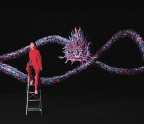Making a Scene

Judith Neilson was just a child when she caught the collecting bug. She was eight or nine years old and living in Bulawayo, Zimbabwe, when on a day out with her family she bought a tiny bottle of Coca-Cola for a single penny. Neilson was hooked. She loved the drink’s looping logo—and of course its taste. Now, the 72-year-old Sydney-based philanthropist owns more than 1,500 items of Coke paraphernalia, from run-of-the-mill red cans to a rare bottle covered in gold crystals that was released to celebrate the 1964 Tokyo Olympics. Her sister has said Neilson has the largest Coke bottle collection in the world, something Neilson claims is not true.
But Neilson’s early experiences hunting for Coke have inspired her subsequent collecting, which has been record breaking—over the past 20 years, Neilson has built what is widely described as the world’s largest collection of Chinese art made since the turn of the millennium, numbering more than 2,500 works by almost 700 artists. Many of those pieces are exhibited on rotation in curated exhibitions at Neilson’s White Rabbit Gallery, a nonprofit,, a total work of art that combines architecture, interior design, visual art and performing arts.
You’re reading a preview, subscribe to read more.
Start your free 30 days





